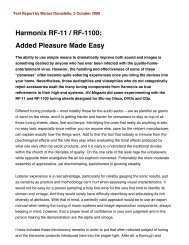Reimyo CAT-777 MK II and KAP-777 [pdf] - Harmonix by Combak
Reimyo CAT-777 MK II and KAP-777 [pdf] - Harmonix by Combak
Reimyo CAT-777 MK II and KAP-777 [pdf] - Harmonix by Combak
- No tags were found...
Create successful ePaper yourself
Turn your PDF publications into a flip-book with our unique Google optimized e-Paper software.
Preamplifier <strong>and</strong> Power Amplifier <strong>Reimyo</strong> <strong>CAT</strong>-<strong>777</strong> <strong>MK</strong> <strong>II</strong> <strong>and</strong> <strong>KAP</strong>-<strong>777</strong>Double mono: the insides of the <strong>CAT</strong>-<strong>777</strong> <strong>MK</strong><strong>II</strong> are designed symmetricallyright down to the length of the cablessimple a circuitry as possible – similarto the single-ended circuit for a 300Btriode amplifier – yet much morepowerful. Mr. Kiuchi spoke about howextremely tedious <strong>and</strong> difficult it was tocomplete this project, despite all theengineering <strong>and</strong> technical assets <strong>and</strong>capabilities available to him as the chiefexecutive of the <strong>Combak</strong> corporategroup. What they finally wound upusing was a single MOSFET transistorin what many would consider as being avastly oversized environment. For all ofthose who look inside the amplifier <strong>and</strong>discover a second transistor: This one operates in opposite phasewith the primary MOSFET <strong>and</strong> gives it a push, so to speak.Functionally it resembles how a vacuum tube with the associatedoutput transformers operates. Nelson Pass popularized thisprinciple with his Aleph circuits.What surprised me was that this one MOSFET per channel inthe <strong>KAP</strong>-<strong>777</strong> was given cooling fins with such an enormoussurface area. Regardless of the performance dem<strong>and</strong>ed of thispower amplifier – it is capable of a steady output of 200 watts at8 ohns <strong>and</strong> 400 watts at 4 ohms – the device always remainedcold. This behavior, according to Kiuchi-san, reflects anobservation that gradually emerged over time: Changes intemperature always have detrimental effects on sound quality.These he minimized through mechanical cooling <strong>and</strong> an allegedly64 image-hifi.com 1/2013


![Reimyo CAT-777 MK II and KAP-777 [pdf] - Harmonix by Combak](https://img.yumpu.com/48993973/6/500x640/reimyo-cat-777-mk-ii-and-kap-777-pdf-harmonix-by-combak.jpg)

